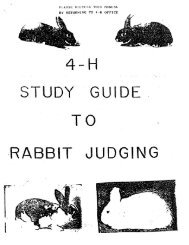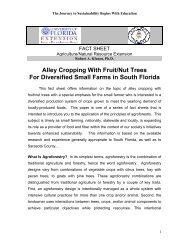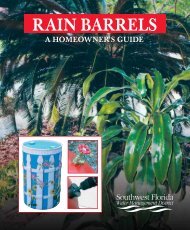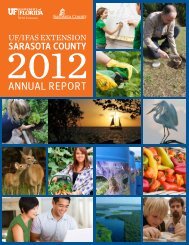Come to 4-H Goat School! - Sarasota County Extension
Come to 4-H Goat School! - Sarasota County Extension
Come to 4-H Goat School! - Sarasota County Extension
Create successful ePaper yourself
Turn your PDF publications into a flip-book with our unique Google optimized e-Paper software.
4-H H<br />
<strong>Goat</strong> <strong>School</strong><br />
Gary Dixon<br />
ohfpygmy@comcast.net
Let’s Let s Take A Look At<br />
Introduction <strong>to</strong> <strong>Goat</strong> types / breeds<br />
Care and Maintenance<br />
Medications and Vaccinations<br />
Odds and Ends<br />
Q and A
What Kind of <strong>Goat</strong> Do You Want?<br />
Dairy Breeds<br />
Meat Breeds<br />
Nubian Alpine LaMancha Oberhasli<br />
Nigerian Dwarf Saanen Toggenburg<br />
Boer<br />
Kiko<br />
Spanish<br />
Dual Purpose<br />
Pygmy
Dairy <strong>Goat</strong>s
Is this what your breeding for?
Meat <strong>Goat</strong>s
Pygmy <strong>Goat</strong>s
Housing<br />
Care and Maintenance<br />
Draft free<br />
Well bedded – large flakes are best and last longest<br />
Bedded higher than surrounding ground <strong>to</strong> prevent<br />
flooding<br />
Closed <strong>to</strong> northerly breezes<br />
Clean up old hay weekly – use in garden or compost<br />
<strong>Goat</strong> doorway large enough for two <strong>to</strong> get through<br />
Capture area<br />
Play or lounging area inside / ramps / covered pallets
Coastal<br />
Hay<br />
Roughage / less protein / cheapest available<br />
Peanut<br />
Roughage / less protein / cheapest available<br />
High protein / lower calcium than Alfalfa/no waste<br />
Best when fed by bowl / very loose<br />
High protein / lower calcium than Alfalfa/no waste<br />
Best when fed by bowl / very loose<br />
Alfalfa<br />
High protein and calcium / expensive<br />
T and A<br />
High protein and calcium / expensive<br />
Stems and waste<br />
Mixed hay<br />
Stems and waste<br />
Roughage / not a lot of protein
Browse<br />
Trimmings from Oak trees is ok<br />
Trimming from citrus tress is ok<br />
Poisonous plant list for Florida
What grain <strong>to</strong> feed??<br />
Horse feed (pelleted ( pelleted or sweet) is not designed<br />
for goats – they do not have the nutrient<br />
content for goats<br />
<strong>Goat</strong> feed – designed for goats / about the same<br />
price as a good horse feed<br />
Pellets / Sweet / All grain<br />
Pellets will not attract flys / and easier <strong>to</strong> portion<br />
control
The Basics: Parts and Vitals
Rear View
Skeletal View
Temperature<br />
Respirations<br />
Pulse<br />
Rumination<br />
Estrus Cycle<br />
Gestation<br />
Vitals<br />
101.5 o <strong>to</strong> 104 o F<br />
Adults: 12 - 20 per minute<br />
Kids: 20 - 40 per minute<br />
70 - 80 beats per minute<br />
1 - 1.5 per minute<br />
18 - 23 days<br />
146 - 156 days
Heart Beat Apparent<br />
Limb Buds Visible<br />
Fetal Development<br />
Differentation Of Digits<br />
Nostrils & Eyes Differentiated<br />
Eyelids Close<br />
Horn Pits Appear<br />
Hair Around Eyes & Muzzle<br />
Tooth Eruption<br />
Hair Covering Body<br />
Length Of Fetus At 30 Days<br />
Length Of Fetus At 145 Days<br />
20 days<br />
28 - 35 days<br />
35 - 42 days<br />
42 - 49 days<br />
49 - 56 days<br />
77 - 84 days<br />
98 - 105 days<br />
98 - 105 days<br />
119 - 126 days<br />
1.4 cm<br />
43 cm
CD/T<br />
Vaccinations / Shots<br />
Yearly <strong>to</strong> goats over one year<br />
Recently some breeders are revaccinating twice per<br />
year<br />
Pregnant dams at one month <strong>to</strong> kidding<br />
If moms vaccinated, then kids at 3 weeks and again<br />
30 later.
Vaccination Schedule<br />
This vaccination schedule has been reviewed by Dr. Robin<br />
Skillman, D.V.M., and is used successfully by several breeders in the<br />
Northern California Area. Please be sure <strong>to</strong> check with your own veterinarian for their<br />
recommendations and approval. At all times check the package instructions of all products for<br />
dosages and proper s<strong>to</strong>rage.<br />
At birth l/4 cc Bo-Se <strong>to</strong> all newborn kids.<br />
Before castration or disbudding l cc Tetanus anti<strong>to</strong>xin S.Q. or I.M.<br />
5 weeks - Triple Sulfa, Sulmet or Albon, 7 days (give orally with syringe)<br />
6 weeks - 1/4” on dial Panacur or Safeguard (Repeat in 3 weeks and as needed)<br />
6 -8 weeks #1 Covexin 8 (2cc I.M. or S.Q.); 10 -12 weeks #2 Covexin 8; 12 - 14 weeks #3<br />
Covexin 8. (Check with your local veterinarian for requirements for your area and follow the<br />
manufacturer’s recommendations for timing between first<br />
injection. and boosters.) Give booster every six months or l month before kidding
Vaccinations Con’t Con<br />
60 days - Dr. Skillman recommends Bo-Se every 60 days <strong>to</strong> growing kids<br />
(Dose l cc per 40 lbs.)<br />
9 weeks - Triple Sulfa, Sulmet, Albon, 7 days<br />
12 weeks - Ivomec S.Q., Cydectin Pour on, orally or as a pour on at the rate of 6 cc per<br />
100 lbs). Valbazen, 1cc per 22 pounds, Tramisol or Safeguard/Panacur) (Repeat as needed -<br />
wormer of choice.)<br />
13 weeks - Triple Sulfa, Sulmet, Albon, 7 days<br />
8 -10 months - Covexin 8 booster (2cc S.Q. or I.M.)<br />
Or on date recommended by manufacturer<br />
One week later - Worm (with wormer of your choice - see listing below)<br />
A & D should be given in December and then again in March <strong>to</strong> all animals
Doe Requirements<br />
Doe Requirements<br />
Before Breeding Does<br />
l month before breeding does - 2cc Covexin 8 as indicated, plus Bo-Se according <strong>to</strong> weight<br />
and deworm.<br />
30 days before kidding Dr. Skillman recommends giving Covexin 8, A&D, Bo-Se and<br />
deworming. (If you do not choose <strong>to</strong> treat pregnant does follow the schedule below. (If you<br />
do not give Covexin 8 at this time kids should be given 2cc CD Anti<strong>to</strong>xin at birth, I.M. and<br />
thereafter follow schedule above for Covexin 8.<br />
At time of kidding give doe and babies Bo-Se.<br />
Day or two after kidding worm. 2 days later give Covexin 8 booster, A&D. Now the doe<br />
is ready <strong>to</strong> be bred when kids are weaned.<br />
Note: Dr. Skillman has recommended that you calendar your bucks and does for a<br />
Bo-Se vaccination every 3 months even if the does are bred. Please check with your<br />
own veterinarian for their recommendation. Warning: The manufacturers of Bo-Se<br />
have put a warning on the label stating NOT <strong>to</strong> give Bo-Se <strong>to</strong> any pregnant<br />
animals. Vaccination of pregnant animals may possibly result in abortions. It is<br />
recommended you give your growing animals Bo-Se every sixty (60) days. I do this<br />
until they’re 18 months old.
Buck Requirements<br />
Bucks<br />
Treat the same as Does, except give Covexin 8 booster as above at 8 -10 months and then<br />
every 6 months.<br />
Bo-Se every three months <strong>to</strong> adult bucks and does.<br />
Bo-Se every sixty (60) days for kids up <strong>to</strong> 18 months.<br />
Worm 2 <strong>to</strong> 4 times per year or more (as indicated by fecal exam)<br />
.<br />
Every day in grain mix l teas. Ammonium Chloride, l/2 Tbls. vegetable oil, 2 Tbls. loose<br />
salt. (Give less of each for younger bucks. Increase as they grow)
Coccidia<br />
Coccidia Treatment/Prevention Dosage<br />
There are many brands and available preparations, i.e., Triple Sulfa,<br />
liquid and powder, Sulmet, liquid and powder, Albon, liquid and powder, which are the<br />
recommended preparations.<br />
Mix and administer according <strong>to</strong> the instructions on the package.<br />
Give orally for 7 days. A fecal exam will reveal if you have coccidia on your property<br />
and in what concentration. Based on this exam, you may not need <strong>to</strong> give Albon, Triple<br />
sulfa or Sulmet <strong>to</strong> your kids if you feed a Deccox or Rumensin (Monensin) feed for the<br />
first four months or administer other coccidiostats as recommended by a veterinarian for<br />
your area.<br />
If the exam does reveal coccidia, treat your kids!<br />
They will grow better for not having bugs.
Hooves / Hoof Trimming<br />
Best every two months<br />
Prevents leg problems and hoof rot<br />
Need sharpest trimmers possible<br />
Fiskers Shop Snips from Home Depot<br />
Tool department<br />
Either done on stanchion or “cowboy cowboy” style<br />
Check dew claws on older goats
Identification<br />
Ear tags – NO WAY JOSE<br />
Tat<strong>to</strong>os<br />
Very acceptable but messy and not permanent<br />
Hard <strong>to</strong> read<br />
Microchip<br />
Avid microchips<br />
Permanent – when done correctly they will not<br />
migrate<br />
Placed at withers or in tail web
Scrapie<br />
&<br />
Premise Identification<br />
Federal Program – voluntary??<br />
All showmen need at least a premise ID<br />
What is scrapie? scrapie<br />
Scrapie is a fatal, degenerative disease affecting the central<br />
nervous system of sheep and goats. It is among a number of<br />
diseases classified as transmissible spongiform<br />
encephalopathies (TSE).. TSEs are the subject of increased<br />
attention and concern because of the discovery of bovine<br />
spongiform encephalopathy (BSE) in cattle, the link between<br />
BSE and variant Creutzfeldt-Jakob Creutzfeldt Jakob disease (vCJD ( vCJD) ) in people,<br />
and feline spongiform encephalopathy (FSE) in cats in<br />
Europe.
<strong>County</strong> Fair Requirements for<br />
Health certificate<br />
Identification<br />
Premise ID number<br />
Tat<strong>to</strong>o or Microchip number<br />
All will be check at weigh-in weigh in and check-in check in<br />
How <strong>to</strong> get a premise ID
What’s What s next after the show?<br />
What can you goat project be next<br />
year?<br />
Will it continue <strong>to</strong> be your pet….your pet .your buddy?<br />
Will you consider expanding from one goat in<strong>to</strong><br />
a small herd…adding herd adding one or two does?<br />
Will you consider breeding?<br />
Can you handle a buck or should you contact a<br />
breeder <strong>to</strong> breed your buck?<br />
Would you like <strong>to</strong> go and try more shows?
How do you buy a goat?<br />
Contact a breeder.<br />
Internet<br />
Word of mouth<br />
Visit a show<br />
Ask questions – Prepare<br />
What does the pedigree mean <strong>to</strong> your<br />
Structure – get you hands on them/walk them/watch them<br />
walk on a lead<br />
What are you looking for? Pet and show.<br />
Kidding his<strong>to</strong>ry / progeny / NPGA Herdbook
References<br />
NPGA – National Pygmy <strong>Goat</strong> Association<br />
Local / State / Regional Breeders<br />
Internet<br />
NPGA<br />
<strong>Goat</strong> 911<br />
Whirlwind Farms Website<br />
Regional and state goat clubs<br />
Southern Pygmy <strong>Goat</strong> Club
Odds and Ends<br />
Next local show is on Dec 13<br />
The Sun Coast Winter Classic – Oak Haven Farm<br />
4H showmanship classes – Champion Showman<br />
Award<br />
Florida State Fair – Feb 2009<br />
Entry forms online now<br />
Entry deadline first week of December<br />
4 day commitment
What do you need <strong>to</strong> show?<br />
A goat (Duh!)<br />
A clean goat<br />
Well fed<br />
Well groomed<br />
Clean, trimmed hooves<br />
A black lead and collar<br />
4-H H Appropriate Clothing<br />
A smile!
Ring Etiquette<br />
Look at the judge<br />
Listen closely <strong>to</strong> the judge’s judge s directions<br />
Watch classes before yours <strong>to</strong> get a clue on the judges<br />
ring procedures.<br />
Remember the showmanship rules you have practiced.<br />
Where <strong>to</strong> stand with your animal<br />
How <strong>to</strong> move around your animal.<br />
Eyes on the judge – Stay focused.<br />
Smile!
Category<br />
General Appearance<br />
• BALANCED & well-blended<br />
• PROPORTIONS typically cobby (compact)<br />
• BREED SPECIFIC MARKINGS distinct<br />
• COAT dense, hair straight, medium long<br />
• EXPRESSION alert, animated; Ears erect<br />
• HEAD typey, symmetrical; profile dished<br />
Structure (Conformation)<br />
• BODY PARTS functional & balanced<br />
-ribcage, chest, barrel broad, deep<br />
-back strong, level<br />
-rump medium long, medium slope<br />
-fore- & hindquarters well angulated, well<br />
aligned, strong, well muscled<br />
-gait smooth & effortless<br />
Health & Condition<br />
• FREE OF DISEASE; displaying vigor<br />
• FREE OF PARASITES; skin & coat clean<br />
• IN GOOD FLESH & MUSCLE<br />
Tractable/Showability<br />
• BEHAVIOR tractable, alert, responsive, trusting, confident &<br />
cooperative<br />
Total Points<br />
Wether Scorecard<br />
Scorecard Points<br />
Wethers<br />
25<br />
25<br />
25<br />
25<br />
100
Category<br />
General Appearance<br />
• BODY MEASUREMENTS meet<br />
specifications for age group<br />
• Genetically HORNED (disbudding<br />
permitted)<br />
• BALANCED & well blended; showing<br />
style<br />
• PROPORTIONS typically cobby; wide<br />
in relation <strong>to</strong> length & height<br />
• CONDITION optimal for age & frame<br />
of animal; HEALTH PERFECT<br />
Head & Expression<br />
• HEAD typey; medium-short; profile<br />
dished<br />
• JAWS broad, strong, well muscled,<br />
symmetrically aligned<br />
• BITE even; neither over nor<br />
undershot<br />
• EYES bright, set well apart, prominent<br />
but not protruding<br />
• EARS firm, medium sized, alertly<br />
erect<br />
• MUZZLE broad, full, rounded; nose<br />
short, wide, flat<br />
• EXPRESSION alert, animated<br />
Coat<br />
• COAT dense, hair straight; medium<br />
long; abundant in bucks<br />
Doe / Buck Scorecard<br />
Doe<br />
14<br />
10<br />
4<br />
Scorecard Points<br />
Buck<br />
14<br />
12<br />
6
Breed Markings<br />
• BREED SPECIFIC MARKINGS distinct;<br />
light accents on muzzle, forehead,<br />
ears, around eyes & tail; contrasting<br />
darker crown, dorsal stripe, cannons,<br />
hocks, hoofs<br />
• OPTIONAL MARKINGS: light girth<br />
areas are acceptable<br />
Neck<br />
• NECK strong, full throated, muscular,<br />
round, blending well in<strong>to</strong> withers<br />
Shoulders<br />
• SHOULDERS well laid back &<br />
angulated; blades firmly attached<br />
• WITHERS nearly level with spine<br />
Chest<br />
• CHEST floor wide; forchest prominent<br />
• HEART GIRTH large, full at the elbows<br />
• RIBS long, well sprung, wide apart<br />
Scorecard Con’t Con<br />
8<br />
3<br />
5<br />
10<br />
12<br />
5<br />
5<br />
10
Barrel<br />
• BARREL symmetrical, broad, deep,<br />
widening <strong>to</strong>ward low-set flanks.<br />
Back<br />
• BACK strong, broad, straight, level<br />
along chine and loin<br />
Rump<br />
• RUMP medium long, medium wide,<br />
neither level nor steep<br />
• HIPS wide, nearly level with back<br />
• THURLS high & wide apart<br />
• PINBONES well apart, prominent<br />
• TAIL symmetrical, set & carried high<br />
Legs & Feet<br />
• LEGS strong, well-muscled, wide<br />
apart, squarely set<br />
• FORELEGS straight<br />
• CANNON BONE short<br />
• ELBOWS close <strong>to</strong> ribs<br />
• HINDLEGS well-angulated, shorthocked,<br />
parallel & aligned with hips;<br />
femur and tibia long, well-muscled;<br />
stifle joint pronounced<br />
• PASTERNS short, strong, resilient<br />
• FEET well shaped, symmetrical; heels<br />
deep, soles level<br />
• GAIT smooth, balanced, ground<br />
covering & effortless<br />
Scorecard Con’t Con<br />
8<br />
8<br />
8<br />
10<br />
8<br />
8<br />
8<br />
12
Mammary System (Does)<br />
• TEATS: Cylindrical,<br />
symmetrically shaped and<br />
placed, milkable,<br />
functional. Free from<br />
deformities &<br />
obstructions. Devoid of<br />
multiple orfices<br />
• UDDER functional, balanced,<br />
firm, elastic, rounded, small<br />
<strong>to</strong> medium sized, wellattached;<br />
high in rear, well<br />
forward in front<br />
Reproductive System (Bucks)<br />
• TESTICLES normal, equal in<br />
size; both fully descended<br />
Mammary System (Bucks)<br />
• TEATS: two single, normal,<br />
non-functional. Devoid of<br />
multiple orfices. Free from<br />
deformities.<br />
Scorecard Con’t Con<br />
12<br />
100<br />
100

















